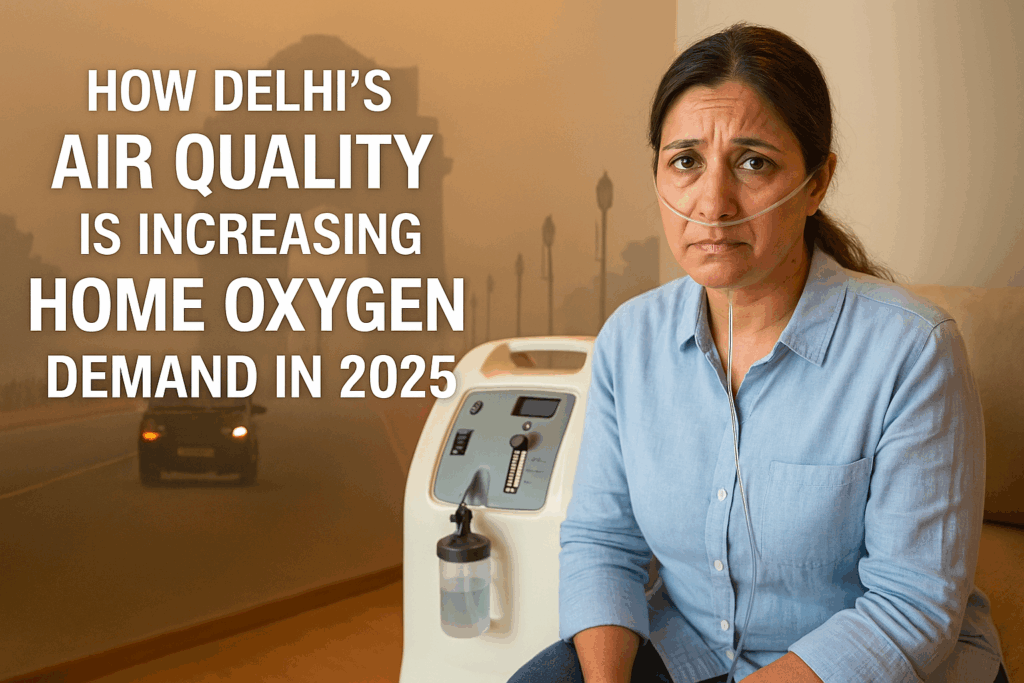
How Delhi’s Air Quality is Increasing Home Oxygen Demand in 2025
🏙️ The Capital That Can’t Breathe
Each winter, Delhi turns into a gas chamber — but in 2025, something has shifted. The haze doesn’t wait for Diwali anymore. It begins creeping in as early as September, tightening its grip well into March. The Air Quality Index (AQI) regularly crosses 400, with certain localities like Anand Vihar, Punjabi Bagh, and Jahangirpuri breaching 500+ — levels considered “severe” and life-threatening.
The enemy is invisible, but its impact is painfully real:
- Burning eyes
- Dry throat
- Chest tightness
- Shortness of breath
- Fatigue that feels like you’ve aged 10 years overnight
For people with chronic respiratory issues, children, and elderly citizens, this is not just pollution — it’s slow suffocation.
👵 “My Mother Couldn’t Breathe Even Indoors…”
Sunita Sharma, 42, from Lajpat Nagar recounts an emotional breakdown.
“We were watching TV, and my mother suddenly began gasping. She has COPD. I ran to the balcony thinking we could get ‘fresh’ air, but it was worse outside. I felt helpless — her face turning pale, oxygen levels dropping on the oximeter. The doctor said we needed an oxygen concentrator at home… immediately.”
Sunita isn’t alone.
Thousands of Delhi families are experiencing similar health scares. And while doctors, hospitals, and ambulances are essential — what families now need is breathable air, right inside their homes.
📈 The Quiet Boom: Home Oxygen Demand Surges
Over the past 12 months, oxygen concentrator rentals in Delhi have skyrocketed. Once considered niche hospital-grade equipment, these machines are now:
- Found in middle-class homes
- Kept in offices for elderly staff
- Rented temporarily for post-COVID care
- Purchased permanently for parents or grandparents
📊 Estimated Growth (Source: Industry reports):
- 60% rise in rentals compared to 2024
- 3x more home ICU setups requested during winters
- Demand peaking not just during festivals, but even in summer smog spells
The air in Delhi has become a year-round threat, and families are adapting.
💨 Why Delhi’s Air is So Dangerous in 2025
In 2025, the AQI is being influenced by:
- Uncontrolled vehicle emissions (despite EV growth)
- Construction dust, due to metro & flyover expansions
- Stubble burning in Punjab and Haryana
- Industrial discharge from NCR’s expanding periphery
- Climate change, leading to stagnant air and lower wind speeds
What’s worse? These pollutants — especially PM2.5 and PM10 particles — are so small they travel deep into the lungs and even enter the bloodstream.
👶 Who’s Most at Risk?
It’s no longer just senior citizens and the immunocompromised. The following groups are increasingly vulnerable:
- Children (especially under age 5)
- Pregnant women
- People recovering from COVID, pneumonia, or tuberculosis
- Athletes, cyclists, and joggers exposed to outdoor air
- Office workers in open-plan buildings with poor air filtration
- Delivery and gig workers constantly on the road
Even healthy individuals are reporting:
- Reduced lung capacity
- Increased fatigue
- Headaches and dizziness
- Psychological symptoms like anxiety from feeling “trapped”
🩺 Understanding Home Oxygen Support
Oxygen concentrators are now the frontline defense in Delhi homes. Here’s why:
- They filter and concentrate oxygen from ambient air
- Provide up to 95% pure oxygen for patients with low SpO2
- Run on electricity and are safe for long-term use
- Some models are portable and travel-ready
🏥 When Should You Use Oxygen at Home?
Consult a doctor, but typical signs that warrant home oxygen:
- SpO2 drops below 93% (even for short periods)
- Frequent breathlessness despite rest
- Noisy breathing or wheezing indoors
- Post-illness recovery (COVID, lung infection)
- Sleep apnea in elderly family members
- Sudden fatigue or chest discomfort during high pollution days
🏠 How Delhi Families Are Creating “Safe Air Rooms”
Here’s what a typical family setup looks like in 2025:
- Oxygen concentrator in the master bedroom
- Air purifier with HEPA filter running 24/7
- Windows sealed with foam or draft stoppers
- Indoor plants like peace lily, snake plant, and areca palm
- Pulse oximeter and thermometer for daily monitoring
- Use of N95 masks indoors when AQI crosses 500+
It’s not a luxury anymore — it’s survival.
🤝 What RentMedicalEquipments.in Is Doing to Help
We’ve responded to the crisis by:
- Maintaining a fleet of new-generation concentrators
- Providing same-day delivery across Delhi NCR
- Offering combo packages (Oxygen + Purifier + Oximeter)
- Creating custom rental plans (daily, weekly, monthly)
- Providing on-call respiratory therapist advice
“We’ve seen customers from areas like South Delhi to Ghaziabad, Noida to Najafgarh. Everyone is affected, and everyone deserves to breathe.”
— Rajat B., Rental Manager at RentMedicalEquipments.in
🔧 Frequently Asked Questions
Q1. Should I rent or buy an oxygen concentrator?
If you need it for a few weeks or months (like winter pollution season or recovery), renting is cost-effective. If it’s for a long-term condition (like COPD), buying is better.
Q2. Is it safe to use a concentrator at home?
Yes, it’s completely safe when used as prescribed. It draws in ambient air, filters it, and provides clean oxygen without any explosion or leakage risks like cylinders.
Q3. Does a purifier work along with oxygen therapy?
Yes. A purifier improves air quality in the room while the concentrator provides pure oxygen. Both should be used simultaneously during high AQI days.
Q4. Can I get oxygen support if I live in a rental flat?
Absolutely. Our machines are compact, quiet, and easy to use in apartments. No installation is required — just plug and breathe.
💡 Expert Tips for 2025
- Check AQI daily using apps like SAFAR or AQI India
- Avoid outdoor exercise on high AQI days
- Use N95/KN95 masks, even indoors if needed
- Replace air purifier filters every 6 months
- Book oxygen concentrators before AQI peaks (don’t wait until someone falls sick)
💬 Real Stories, Real Impact
“We never imagined needing oxygen at home. But this year, we didn’t take chances. We rented a machine early — and it made all the difference for my asthmatic son.”
— Priya, Noida
“It’s like building a hospital room in your bedroom. But it’s what Delhi needs right now.”
— Mahesh, Model Town
🫁 Final Words: Delhi Is Changing. Are You Ready?
We used to fear water shortages, power cuts, and price hikes.
But in 2025, the fear is more primal — “Will I be able to breathe tomorrow?”
Delhi’s air is no longer just polluted. It’s dangerous.
But there’s hope — in technology, preparation, and awareness.
By acting early, getting the right equipment, and creating safe indoor spaces, we’re not just surviving this crisis.
We’re reclaiming the air — one breath at a time.
Mumbai
Delhi
- BIPAP Machine on Rent in Delhi
- Air Purifier On Rent In Delhi
- Medical Equipments On Rent In Greater Kailash (GK)
- Medical Equipments On Rent In Janakpuri
- Medical Equipments On Rent In Preet Vihar
- Medical Equipments On Rent In Saket
- Medical Equipments On Rent In Connaught Place
- Medical Equipments On Rent In Vasant Kunj
- Medical Equipments On Rent In Karol Bagh
- Medical Equipments On Rent In Daryaganj
- Medical Equipments On Rent In Paharganj
- Medical Equipments On Rent In Patel Nagar Delhi
- Medical Equipments On Rent In Vasant Vihar
- Medical Equipments On Rent In Rajendra Place
- Medical Equipments On Rent In Mayur Vihar
- Medical Equipments On Rent In Laxmi Nagar
- Medical Equipments On Rent In Hauz Khas
- Medical Equipments On Rent In Malviya Nagar
- Medical Equipments On Rent In South Extension
- Medical Equipments On Rent In Lajpat Nagar
- Medical Equipments On Rent In Green Park
- Medical Equipments On Rent In Kalkaji
- Medical Equipments On Rent In Nehru Place
- Medical Equipments On Rent In Uttam Nagar
- Medical Equipments On Rent In Ghaziabad
- Medical Equipments On Rent In New Friends Colony
- Medical Equipments On Rent In Defence Colony
- Medical Equipments On Rent In Anand Vihar
Delhi NCR
- CPAP Machine on Rent in Lucknow
Lucknow
© 2025. All right reserverd by Rent Medical Equipment





